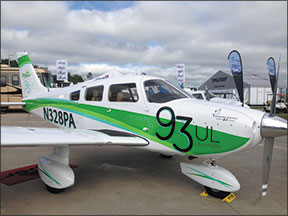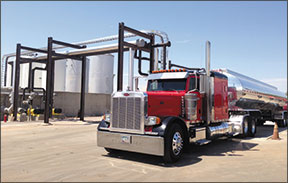The notion that ordinary automotive pump gas can be a cheaper alternative to increasingly expensive avgas has had a rough time of it. Mogas gained traction during the 1980s and saw wide enough distribution to be a player, but a shrinking price Delta against avgas, a cold shoulder from the engine manufacturers and a rising flood of ethanol has stunted the mogas movement.

Now, a company called Airworthy Autogas wants to make another run at the market with a boutique blend of mogas designed to forthrightly address three complaints about pump gas intended for cars: lack of assured octane, a guarantee of zero ethanol and satisfying beefs raised by the engine manufacturers about both.
The critical piece of the mogas puzzle is price. Airworthy Autogas is sure its product will be cheaper than avgas, but it’s not sure how much cheaper and it won’t know that until production is stabilized and with a few months of history.
A 50-cent price Delta might not be enough to lure owners into buying the necessary STCs and/or convincing FBOs to install the tankage. But this new product has at least one thing going for it: It meets the specs of Lycoming’s SI 1070 and thus, for the first time, has the blessing of an engine manufacturer.
what is this stuff?
Airworthy Autogas is the brainchild of several fuel executives including Mark Ellery and a business offshoot of CalJet of America, a major fuel blender and terminal in Phoenix. (Airworthy Autogas is an independent company.)
CalJet’s Phoenix facility is the sort of terminal found all over the country, at the terminus of pipelines delivering both finished fuels and what’s called blendstock for oxygenate blending, or BOBs. Because ethanol is too corrosive to be delivered via pipeline, it’s blended into BOBs at the terminals before being delivered to distributors or retailers as finished fuel. Because a shot of ethanol—up to 10 percent—increases octane, BOBs are delivered octane deficient, except for the small volume of E0 fuels intended for the marine, RV and sporting markets. This includes premium BOBs, whose final octane is also set by the addition of ethanol.
Ellery told us that Airworthy Autogas is run-of-the-pipeline premium BOB to which the company will add a proprietary additive package to guarantee a minimum octane of 93 and Reid vapor pressures more in line with certified avgas or no higher than 9 PSI.

In the boutique fuels market—and Airworthy Autogas will certainly be one of those—transportation can be a deal breaker. The volumes are too small for pipeline transport and the next best alternative, rail car, may be too expensive if the price difference against avgas isn’t high enough.
Ellery says the company’s solution to this is to transport the finished fuel to a market only within 400 to 500 miles of Phoenix, for which it has a dedicated fleet of 50 tanker trucks. For markets beyond that radius, Airworthy intends to “cut and paste” the blending technology to other terminals around the country that are, presumably, closer to the final markets.
The capital required to do this, while not trivial, involves little more than tank farm and blending facilities. The remainder of the problem is simply truck transportation to local or regional markets. Because Airworthy Autogas is an unleaded fuel, it won’t require segregated tanker trucks, as 100LL now does, further reducing transportation costs.
Airworthy Autogas meets the ASTM D-4814 standard that describes virtually all of the automotive fuel sold in the U.S, but it tightens up two critical specs that Lycoming lists in its SI 1070 bulletin approving a range of engines for mogas use. At 93 octane, Airworthy meets SI 1070, but exceeds the actual octane requirement for most low-compression engines that could burn it. More critical is Reid vapor pressure. To prevent vapor lock in engines taken to high altitude, the ASTM D-910 spec for avgas calls for vapor pressures between 5.5 and 7.1 PSI. Airworthy is aiming for under 9 PSI, compared to values as high as 12 PSI for automotive gasolines.
“We’re not using anything that refiners haven’t used in years gone by, but we’re just doing it in a different manner,” Ellery says. As for volume, Airworthy’s new facility in Phoenix is designed to have sufficient capacity for a regional market. “When we go online, we will have sufficient volume to serve the entire U.S. Southwest region, including southern California,” Ellery adds.
Where’s the Market?
Although our surveys—including the most recent summarized on page 13—show wide interest in mogas, there’s not much of it around on airports. Only about 115 airports have mogas pumps, with a strong concentration of airports in the Midwest. We hear conflicting reports about how much non-ethanol premium mogas is available at terminals for distribution at airports willing to install the tankage. But Todd Petersen, whose Petersen Aviation developed and still sells the original 1980s autogas STCs, says that at least the perception of difficult E0 supplies has diminished interest in mogas. For the past couple of years, STC sales have picked up a bit, but mostly in the European market where avgas costs twice as much as it does in the U.S.
Airworthy’s Ellery told us he’s aware of the supply issues and rather than attempt widespread distribution of Airworthy Autogas, the company will aim first for the flight training market around Phoenix and possibly in Florida.
Even at that, Airworthy knows that two significant barriers to mogas uptake remain, one obvious and one not so obvious.

With the exception of FBOs that have already adopted mogas, the U.S. FBO market has been distinctly chilly toward installing tankage for a second gasoline. That was one reason that 80/87 avgas was phased out in favor of the single compromise product that became 100LL. Ellery said Airworthy might be amenable to installing or leasing tanks, if that’s what it takes.
“We don’t want to be vertically integrated. The last thing I want to do is become an FBO. But I’d be more than happy to work with an FBO facing the infrastructure problem,” Ellery said. This sort of business model—with tanks installed and owned by the fuel provider—is more common in Europe.
Brand contracts are another barrier. “I can’t tell you the walls I run into immediately when I knock on the door of an FBO. If they’re branded with a refiner, they slam the door on you. They’re not allowed to have a competing fuel,” Ellery said. And that extends to competition that isn’t another brand of avgas.
Is This Doable?
To answer that question, we reviewed Airworthy’s plans with both Todd Petersen and fuels chemist Ed Kollin, who’s working on his own additive project to produce an unleaded 100-octane fuel.
Kollin still sees vapor pressure as an issue, because vapor pressure is driven down by light or volatile fractions that evaporate as the fuel ages. There’s also some octane loss due to that process. But he concedes the octane issue might not be real for carbureted engines that don’t require the full 91 or 93 octane, and according to Petersen’s STC list, that’s a large number. Furthermore, although four engine groups on Lycoming’s SI 1070 list are fuel injected, only a couple of Petersen’s approvals cover fuel-injected engines. Fuel-injected engines can be more susceptible to vapor pressure-related issues because injection pumps can cavitate due to vapor lock.
Still, Petersen says he’s happy to see Airworthy Autogas’s introduction and if it succeeds, he’ll expect to sell more autogas STCs. Lycoming’s approvals apply just to the engines; the airframe also requires an approval and Petersen sells both.
“It’ll be great if they’re able to get this installed,” Petersen said of Airworthy’s efforts. “Just getting a reliable source of no-ethanol gas has been a persistent problem,” he adds.
“When Lycoming approved D-4814 autogas, I took that to be an endorsement of the basic autogas. They are specifying a little lower vapor pressure and a higher octane, but when it comes to the core components of it, it’s the same,” Petersen says.
Conclusion
Although critics of autogas insist that vapor pressures in the range of typical autofuel will lead to accidents, we don’t see a record of that in the NTSB’s files. In fact, there are few accidents at all in which autogas or mogas—we use the terms interchangeably—are even mentioned.
We think Airworthy Autogas’s major challenge is not technical, but in marketing and distribution. If, through effective marketing, it can convince owners to drop what appear to be unfounded biases against avgas, it could very we’ll make inroads. It’s widely assumed that whatever fuel replaces 100LL will cost more than the $6 average national cost in October of 2013. If that turns out to be true, Airworthy Autogas could sell for $1.50 or so less than unleaded 100-octane avgas. Could that entice enough pilots to start buying it and asking FBOs to carry it? Mark Ellery is counting on it.





